History of Saudi Arabia
The history of Saudi Arabia in its current form as a nation state began with the emergence of the Al Saud dynasty in central Arabia in 1744 and the subsequent establishment of the Emirate of Diriyah. The territory that now constitutes Saudi Arabia was the site of several ancient cultures and civilizations. The prehistory of Saudi Arabia shows some of the earliest traces of human activity in the world.[1] The world's second-largest religion,[2] Islam, emerged in modern-day Saudi Arabia. In the early 7th century, the Islamic prophet Muhammad united the population of Arabia and created a single Islamic religious polity.[3] Following his death in 632, his followers rapidly expanded the territory under Muslim rule beyond Arabia, conquering huge and unprecedented swathes of territory (from the Iberian Peninsula in the West to modern-day Pakistan in the East) in a matter of decades. Arab dynasties originating from modern-day Saudi Arabia founded the Rashidun (632–661), Umayyad (661–750), Abbasid (750–1517) and Fatimid (909–1171) caliphates as well as numerous other dynasties in Asia, Africa and Europe.[4][5][6][7][8]
Part of a series on the |
|---|
| History of Saudi Arabia |
 |
|
|
The area of modern-day Saudi Arabia formerly consisted of mainly four distinct historical regions: Hejaz, Najd and parts of Eastern Arabia (Al-Ahsa) and Southern Arabia ('Asir).[9] The modern Kingdom of Saudi Arabia was founded in 1932 by Ibn Saud. He united the four regions into a single state through a series of conquests beginning in 1902 with the capture of Riyadh, the ancestral home of his family. Saudi Arabia has since been a absolute monarchy governed along Islamist lines. Saudi Arabia is sometimes called "the Land of the Two Holy Mosques" in reference to Al-Masjid al-Haram (in Mecca) and Al-Masjid an-Nabawi (in Medina), the two holiest places in Islam.
Petroleum was discovered on 3 March 1938 and followed up by several other finds in the Eastern Province.[10] Saudi Arabia has since become the world's second largest oil producer (behind the US) and the world's largest oil exporter, controlling the world's second largest oil reserves and the sixth largest gas reserves.[11]
From 1902 until his death in 1953, Saudi Arabia's founding father, Ibn Saud, ruled the Emirate of Riyadh (1902-13), the Emirate of Nejd and Hasa (1913-21), the Sultanate of Nejd (1921-26), the Kingdom of Hejaz and Nejd (1926-32) and finally as King of Saudi Arabia (1932-1953). Thereafter six of his sons in succession have reigned over the kingdom:
- Saud, the immediate successor of Abdulaziz, faced opposition from most in the royal family and was eventually deposed.
- Faisal replaced Saud in 1964. Until his murder by a nephew in 1975, Faisal presided over a period of growth and modernization fueled by oil wealth. Saudi Arabia's role in the 1973 oil crisis and, the subsequent rise in the price of oil, dramatically increased the country's political significance and wealth.
- Khalid, Faisal's successor, reigned during the first major signs of dissent: Islamist extremists temporarily seized control of the Grand Mosque in Mecca in 1979.
- Fahd became king in 1982. During his reign Saudi Arabia became the largest oil producer in the world. However, internal tensions increased when the country allied itself with the United States, and others, in the Gulf War of 1991. In the early 2000s, the Islamist opposition to the regime carried out a series of terrorist attacks.
- Abdullah succeeded Fahd in 2005. He instituted a number of mild reforms to modernize many of the country's institutions and, to some extent, increased political participation.
- Salman became king in 2015.
Pre-Islamic Arabia
There is evidence that human habitation in the Arabian Peninsula dates back to about 63,000 years ago.[12][13] Nevertheless, the stone tools from the Middle Paleolithic age along with fossils of other animals discovered at Ti's al Ghadah, in northwestern Saudi Arabia, might imply that hominids migrated through a "Green Arabia" between 300,000 and 500,000 years ago.[14]
Archaeology has revealed some early settled civilizations: the Dilmun civilization on the east of the Arabian Peninsula, Thamud north of the Hejaz, and Kindah kingdom and Al-Magar civilization in the central of Arabian Peninsula. The earliest known events in Arabian history are migrations from the peninsula into neighbouring areas.[15]
There is also evidence from Timna (Israel) and de:Tell el-Kheleifeh (Jordan) that the local Qurayya/Midianite pottery originated within the Hejaz region of NW Saudi Arabia, which suggests that the biblical Midianites originally came from the Hejaz region of NW Saudi Arabia before expanding into Jordan and Southern Israel.[16][17]
On 9 June 2020, the discovery of a 35-meter long triangular megalithic monument in Dumat al-Jandal dated back to VI millennium BC which presumably dedicated to ritual practices was published in the journal Antiquity. Archaeological researchers from France, Saudi Arabia and Italy, headed by Olivia Munoz believe that these findings illuminate a pastoralist nomadic lifestyle and a ritual used in prehistoric Arabia.[18][19]
The spread of Islam
Muhammad, the Prophet of Islam, was born in Mecca in about 570 and first began preaching in the city in 610, but migrated to Medina in 622. From there, He and His companions united the tribes of Arabia under the banner of Islam and created a single Arab Muslim religious polity in the Arabian Peninsula.
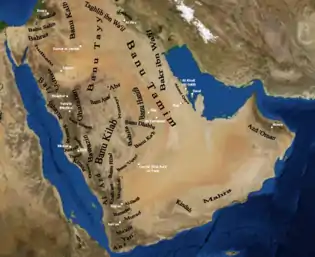
Following Muhammad's death in 632, Abu Bakr became leader of the Muslims as the first Caliph. After putting down a rebellion by the Arab tribes (known as the Ridda wars, or "Wars of Apostasy"), Abu Bakr attacked the Byzantine Empire. On his death in 634, he was succeeded by Umar as caliph, followed by Uthman ibn al-Affan and Ali ibn Abi Talib. The period of these first four caliphs is known as the Rashidun or "rightly guided" Caliphate (al-khulafā' ar-rāshidūn). Under the Rashidun Caliphs, and, from 661, their Umayyad successors, the Arabs rapidly expanded the territory under Muslim control outside of Arabia. In a matter of decades Muslim armies decisively defeated the Byzantine army and destroyed the Persian Empire, conquering huge swathes of territory from the Iberian peninsula to India. The political focus of the Muslim world then shifted to the newly conquered territories.[20][21]
Nevertheless, Mecca and Medina remained the spiritually most important places in the Muslim world. The Quran requires every able-bodied Muslim who can afford it, as one of the five pillars of Islam, to make a pilgrimage, or Hajj, to Mecca during the Islamic month of Dhu al-Hijjah at least once in his or her lifetime.[22] The Masjid al-Haram (the Grand Mosque) in Mecca is the location of the Kaaba, Islam's holiest site, and the Masjid al-Nabawi (the Prophet's Mosque) in Medina is the location of Muhammad tomb; as a result, from the 7th century, Mecca and Medina became the pilgrimage destinations for large numbers of Muslims from across the Muslim world.[23]
Umayyad and Abbasid periods
After the fall of the Umayyad empire in 750 CE, most of what was to become Saudi Arabia reverted to traditional tribal rule soon after the initial Muslim conquests, and remained a shifting patchwork of tribes and tribal emirates and confederations of varying durability.[24][25]
Muawiyah I, the first Umayyad caliph, took an interest in his native Mecca, erecting buildings and digging wells.[26] Under his Marwanids successors, Mecca became the abode of poets and musicians. Even then, Medina eclipsed Mecca in importance for much of the Umayyad period, as it was home to the new Muslim aristocracy.[26] Under Yazid I, the revolt of Abd Allah bin al-Zubair brought Syrian troops to Mecca.[26] An accident led to a fire that destroyed the Kaaba, which was rebuilt by Ibn al-Zubair.[26] In 747, a Kharidjit rebel from Yemen seized Mecca unopposed, but he was soon defeated by Marwan II.[26] In 750, Mecca, along with the rest of the caliphate, was passed to the Abbasids.[26]
Sharifate of Mecca
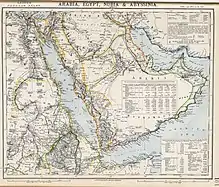
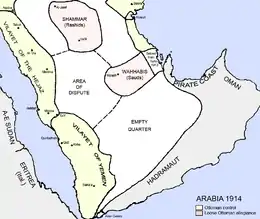
From the 10th century (and, in fact, until the 20th century) the Hashemite Sharifs of Mecca maintained a state in the most developed part of the region, the Hejaz. Their domain originally comprised only the holy cities of Mecca and Medina but in the 13th century it was extended to include the rest of the Hejaz. Although the Sharifs exercised at most times independent authority in the Hejaz, they were usually subject to the suzerainty of one of the major Islamic empires of the time. In the Middle Ages, these included the Abbasids of Baghdad, and the Fatimids, Ayyubids and Mamluks of Egypt.[24]
Ottoman Era
Beginning with Selim I's acquisition of Medina and Mecca in 1517, the Ottomans, in the 16th century, added to their Empire the Hejaz and Asir regions along the Red Sea and the al-Hasa region on the Persian Gulf coast, these being the most populous parts of what was to become Saudi Arabia. They also laid claim to the interior, although this remained a rather nominal suzerainty. The degree of control over these lands varied over the next four centuries with the fluctuating strength or weakness of the Empire's central authority. In the Hejaz, the Sharifs of Mecca were largely left in control of their territory (although there would often be an Ottoman governor and garrison in Mecca). On the eastern side of the country, the Ottomans lost control of the al-Hasa region to Arab tribes in the 17th century but regained it again in the 19th century. Throughout the period, the interior remained under the rule of a large number of petty tribal rulers in much the same way as it had in previous centuries.[27]
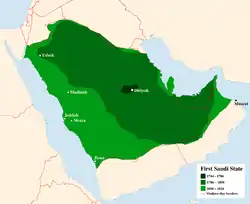
Rise of Wahhabism and the first Saudi state
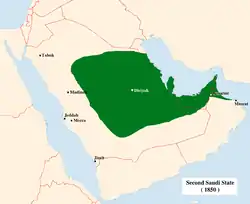
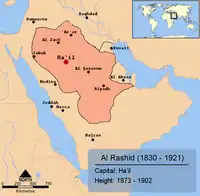
The emergence of the Saudi dynasty began in central Arabia in 1744. In that year, Muhammad ibn Saud, the tribal ruler of the town of Ad-Dir'iyyah near Riyadh, joined forces with the religious leader Muhammad ibn Abd-al-Wahhab,[28] the founder of the Wahhabi movement.[29] This alliance formed in the 18th century provided the ideological impetus to Saudi expansion and remains the basis of Saudi Arabian dynastic rule today. Over the next 150 years, the fortunes of the Saud family rose and fell several times as Saudi rulers contended with Egypt, the Ottoman Empire, and other Arabian families for control of the peninsula.[13][24]
The first Saudi State was established in 1744 in the area around Riyadh and briefly controlled most of the present-day territory of Saudi Arabia through conquests made between 1786 and 1816; these included Mecca and Medina.[30] Concerned at the growing power of the Saudis, the Ottoman Sultan, Mustafa IV, instructed his viceroy in Egypt, Mohammed Ali Pasha, to reconquer the area. Ali sent his sons Tusun Pasha and Ibrahim Pasha who were eventually successful in routing the Saudi forces in 1818 and destroyed the power of the Al Saud.[13][24]
Return to Ottoman domination
The Al Saud returned to power in 1824 but their area of control was mainly restricted to the Saudi heartland of the Najd region, known as the second Saudi state. However, their rule in Najd was soon contested by new rivals, the Rashidis of Ha'il. Throughout the rest of the 19th century, the Al Saud and the Al Rashid fought for control of the interior of what was to become Saudi Arabia. By 1891, the Al Saud were conclusively defeated by the Al Rashid, who drove the Saudis into exile in Kuwait.[13][24][31]
Meanwhile, in the Hejaz, following the defeat of the first Saudi State, the Egyptians continued to occupy the area until 1840. After they left, the Sharifs of Mecca reasserted their authority, albeit with the presence of an Ottoman governor and garrison.[24]
Arab Revolt
By the early 20th century, the Ottoman Empire continued to control or have suzerainty (albeit nominal) over most of the peninsula. Subject to this suzerainty, Arabia was ruled by a patchwork of tribal rulers (including the Al Saud who had returned from exile in 1902 – see below) with the Sharif of Mecca having preeminence and ruling the Hejaz.[24][27][32]
In 1916, with the encouragement and support of Britain and France[33] (which were fighting the Ottomans in the World War I), the sharif of Mecca, Hussein bin Ali, led a pan-Arab revolt against the Ottoman Empire with the aim of securing Arab independence and creating a single unified Arab state spanning the Arab territories from Aleppo in Syria to Aden in Yemen.
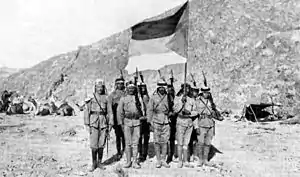
The Arab army comprised bedouin and others from across the peninsula, but not the Al Saud and their allied tribes who did not participate in the revolt partly because of a long-standing rivalry with the Sharifs of Mecca and partly because their priority was to defeat the Al Rashid for control of the interior. Nevertheless, the revolt played a part in the Middle-Eastern Front and tied down thousands of Ottoman troops thereby contributing to the Ottomans' World War I defeat in 1918.[24][34]
However, with the subsequent partitioning of the Ottoman Empire, the British and French reneged on promises to Hussein to support a pan-Arab state. Although Hussein was acknowledged as King of the Hejaz, Britain later shifted support to the Al Saud, leaving him diplomatically and militarily isolated. The revolt, therefore, failed in its objective to create a pan-Arab state but Arabia was freed from Ottoman suzerainty and control.[34]
Unification
In 1902, Abdul-Aziz Al Saud, leader of the Al Saud, returned from exile in Kuwait to resume the conflict with the Al Rashid, and seized Riyadh – the first of a series of conquests ultimately leading to the creation of the modern state of Saudi Arabia in 1930. The main weapon for achieving these conquests was the Ikhwan, the Wahhabist-Bedouin tribal army led by Sultan bin Bajad Al-Otaibi and Faisal al-Duwaish.[31][35][36]
By 1906, Abdulaziz had driven the Al Rashid out of Najd and the Ottomans recognized him as their client in Najd. His next major acquisition was Al-Hasa, which he took from the Ottomans in 1913, bringing him control of the Persian Gulf coast and what would become Saudi Arabia's vast oil reserves. He avoided involvement in the Arab Revolt, having acknowledged Ottoman suzerainty in 1914, and instead continued his struggle with the Al Rashid in northern Arabia. In 1920, the Ikhwan's attention turned to the south-west, when they seized Asir, the region between the Hejaz and Yemen. In the following year, Abdul-Aziz finally defeated the Al Rashid and annexed all northern Arabia.[25][31]
Prior to 1923, Abdulaziz had not risked invading the Hejaz because Hussein bin Ali, King of the Hejaz, was supported by Britain. However, in that year, the British withdrew their support. At a conference in Riyadh in July 1924 complaints were stated against the Hejaz; principally that pilgrimage from Najd was prevented and it boycotted the implementation of certain public policy in contravention of shari'a. Ikhwan units were massed on a large scale for the first time, and under Khalid bin Lu'ayy and Sultan bin Bajad rapidly advanced on Mecca laying waste to symbols of "heathen" practices.[37] The Ikhwan completed their conquest of the Hejaz by the end of 1925. On 10 January 1926 Abdulaziz declared himself King of the Hejaz and, then, on 27 January 1927 he took the title King of Najd (his previous title was Sultan). The use of the Ikhwan to effect the conquest had important consequences for the Hejaz: The old cosmopolitan society was uprooted, and version of Wahhabi culture was imposed as a new compulsory social order.[38]
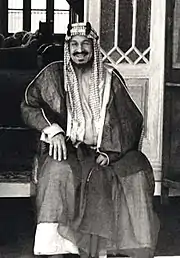
By the Treaty of Jeddah, signed on 20 May 1927, the United Kingdom recognized the independence of Abdul-Aziz's realm (then known as the Kingdom of Hejaz and Najd).[25][31] After the conquest of the Hejaz, the Ikhwan leaders wanted to continue the expansion of the Wahhabist realm into the British protectorates of Transjordan, Iraq and Kuwait. Abdul-Aziz, however, refused to agree to this, recognizing the danger of a direct conflict with the British. The Ikhwan therefore revolted but were defeated in the Battle of Sabilla in 1929, and the Ikhwan leadership were massacred.[39]
In 1930, the two kingdoms of the Hejaz and Najd were united as the 'Kingdom of Saudi Arabia'.[31][35] Boundaries with Transjordan, Iraq, and Kuwait were established by a series of treaties negotiated in the 1920s, with two "neutral zones" created, one with Iraq and the other with Kuwait. The country's southern boundary with Yemen was partially defined by the 1934 Treaty of Ta'if, which ended a brief border war between the two states.[40]
Modern history
Abdulaziz's military and political successes were not mirrored economically until vast reserves of oil were discovered in 1938 in the Al-Hasa region along the Persian Gulf coast. Development began in 1941 and by 1949 production was in full swing.
In February 1945, King Abdul Aziz met President Franklin D. Roosevelt aboard the USS Quincy in the Suez Canal. A historic handshake agreeing on supplying oil to the United States in exchange for guaranteed protection to the Saudi regime is still in force today. It has survived seven Saudi Kings and twelve US presidents.
Abdulaziz died in 1953. King Saud succeeded to the throne on his father's death in 1953. Oil provided Saudi Arabia with economic prosperity and a great deal of political leverage in the international community. At the same time, the government became increasingly wasteful and lavish. Despite the new wealth, extravagant spending led to governmental deficits and foreign borrowing in the 1950s.[25][41][42]
However, by the early 1960s an intense rivalry between the King and his half-brother, Prince Faisal emerged, fueled by doubts in the royal family over Saud's competence. As a consequence, Saud was deposed in favor of Faisal in 1964.[25]
The mid-1960s saw external pressures generated by Saudi-Egyptian differences over Yemen. When civil war broke out in 1962 between Yemeni royalists and republicans, Egyptian forces entered Yemen to support the new republican government, while Saudi Arabia backed the royalists. It is estimated that between 1962 and 1970, the monarchy in Saudi Arabia faced one of the gravest threats to its survival from Yemen.[43] Meanwhile, Ahmad Shukeiri was relieved from his post as representative of Saudi Arabia at the UN after praising the fascist far-right organization Tacuara (that as in his the past views and diatribe was disapproved by other Arabs[44]) and this embarrassed Arabs and caused Latin American objections.[45][46][47][48] Shukeiri recalled the New York Times piece weeks earlier, that article's headline states clearly "Argentine Youths in Nazi Group Salute and Cry: 'Hail Tacuara!"[49] Days before his dismissal, the Hutchinson News reported that Arab diplomats, who claim to be in close touch with the Saudi Arabian government, became so annoyed at Ambassabor Shukairy for his rash speech that they spoke of urging Saudi Prince Faisal to recall him. And this case was not the first they disapproved of his views and rhetoric.[44] (In WW2 Shukairy fought tor Hitler[50][51] and in 1946, after joining the Arab Higher Committee Shukairy restituted Goebbels' Nazi propaganda rhetoric.[52] In 1961 he has used the canard of questioning loyalty of a Catholic representative to his country “reasoning” because he is a “Jew”. Which reminded Nazi Goebbels’ hate propaganda, again.[53]) The Forward reported that Shukairy, was a close collaborator with the mufti. He continues to spread Nazi-style hatred of Jews, even in the United Nations.[54] He had different of opinions with king Faisal in approach to Yemen.[55]
Tensions with Yemen subsided only after 1967, when Egypt withdrew its troops from Yemen. Saudi forces did not participate in the Six-Day (Arab–Israeli) War of June 1967, but the government later provided annual subsidies to Egypt, Jordan, and Syria to support their economies.[25][56]
During the 1973 Arab-Israeli war, Saudi Arabia participated in the Arab oil boycott of the United States and Netherlands. A member of the OPEC, Saudi Arabia had joined other member countries in moderate oil price increases beginning in 1971. After the 1973 war, the price of oil rose substantially, dramatically increasing Saudi Arabia's wealth and political influence.[25]
Faisal was assassinated in 1975 by his nephew, Prince Faisal bin Musaid,[57] and was succeeded by his half-brother King Khalid during whose reign economic and social development continued at an extremely rapid rate, revolutionizing the infrastructure and educational system of the country; in foreign policy, close ties with the US were developed.
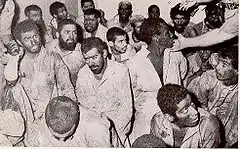
In 1979, two events occurred which the Al Saud perceived as threatening the regime, and had a long-term influence on Saudi foreign and domestic policy. The first was the Iranian Islamic revolution. There were several anti-government riots in the region in 1979 and 1980. The second event was the seizure of the Grand Mosque in Mecca by Islamist extremists. The militants involved were in part angered by what they considered to be the corruption and un-Islamic nature of the Saudi regime.[25][41][42][58] Part of the response of the royal family was to enforce a much stricter observance of Islamic and traditional Saudi norms. Islamism continued to grow in strength.[25][41][42][58]
King Khalid died in June 1982.[25] Khalid was succeeded by his brother King Fahd in 1982, who maintained Saudi Arabia's foreign policy of close cooperation with the United States and increased purchases of sophisticated military equipment from the United States and Britain.
Following the Iraqi invasion of Kuwait in 1990, Saudi Arabia joined the anti-Iraq Coalition. King Fahd, fearing an attack from Iraq, invited soldiers from the US and 32 other countries to Saudi Arabia. Saudi and Coalition forces also repelled Iraqi forces when they breached the Kuwaiti-Saudi border in 1991( see Battle of Khafji).[59]
In 1995, Fahd suffered a debilitating stroke and the Crown Prince, Prince Abdullah assumed day-to-day responsibility for the government. In 2003, Saudi Arabia refused to support the US and its allies in the invasion of Iraq.[25] Terrorist activity within Saudi Arabia increased dramatically in 2003, with the Riyadh compound bombings and other attacks, which prompted the government to take more stringent action against terrorism.[58]
In 2005, King Fahd died and his half-brother, Abdullah, ascended to the throne. Despite growing calls for change, the king has continued the policy of moderate reform.[60] King Abdullah has pursued a policy of limited deregulation, privatization and seeking foreign investment. In December 2005, following 12 years of talks, the World Trade Organization gave the green light to Saudi Arabia's membership.[61]
As the Arab Spring unrest and protests began to spread across Arab world in early 2011, King Abdullah announced an increase in welfare spending. No political reforms were announced as part of the package.[62] At the same time, Saudi troops were sent to participate in the crackdown on unrest in Bahrain. King Abdullah gave asylum to deposed President Zine El Abidine Ben Ali of Tunisia and telephoned President Hosni Mubarak of Egypt (prior to his deposition) to offer his support.[63]
On 23 January 2015, King Abdullah died and was succeeded by King Salman.
See also
References
- 88,000-Year-Old Finger Bone Pushes Back Human Migration Dates, www.nationalgeographic.com
- "The Global Religious Landscape". Pew Forum. 18 December 2012.
- Lindsay, James E. (2005). Daily Life in the Medieval Islamic World. Greenwood Press. p. 33. ISBN 978-0-313-32270-9.
- "Islam, The Arab Empire Of The Umayyads". history-world.org. Archived from the original on 15 December 2014. Retrieved 1 April 2017.
- "The Arab Empire | Mohammed | Umayyad Empire History". www.historybits.com.
- "Top 10 Greatest Empires In History". Listverse. 22 June 2010.
- Pillalamarri, Akhilesh (22 February 2015). "The 5 Most Powerful Empires in History". The National Interest.
- "10 Greatest Empires in the History of World". Top Ten Lists. 24 March 2010.
- Madawi Al-Rasheed (2013). A Most Masculine State: Gender, Politics and Religion in Saudi Arabia. p. 65. ISBN 978-0-521-76104-8.
-
- Caryl, Sue (20 February 2014). "1938: Oil Discovered in Saudi Arabia". National Geographic. National Geographic Society. Retrieved 27 November 2016.
- Learsy, Raymond (2011). Oil and Finance: The Epic Corruption. p. 89.
- "International – U.S. Energy Information Administration (EIA)". eia.gov.
- "Early humans settled in Arabia". usatoday. Retrieved 12 November 2016.
- Saudi Embassy (US) Website Archived 4 March 2016 at the Wayback Machine retrieved 20 January 2011
- Roberts, Patrick; Stewart, Mathew; Alagaili, Abdulaziz N.; Breeze, Paul; Candy, Ian; Drake, Nick; Groucutt, Huw S.; Scerri, Eleanor M. L.; Lee-Thorp, Julia; Louys, Julien; Zalmout, Iyad S.; Al-Mufarreh, Yahya S. A.; Zech, Jana; Alsharekh, Abdullah M.; al Omari, Abdulaziz; Boivin, Nicole; Petraglia, Michael (29 October 2018). "Fossil herbivore stable isotopes reveal middle Pleistocene hominin palaeoenvironment in 'Green Arabia'". Nature Ecology & Evolution. 2 (12): 1871–1878. doi:10.1038/s41559-018-0698-9. hdl:10072/382068. PMID 30374171.
- Philip Khuri Hitti (2002), History of the Arabs, Revised: 10th Edition
- Levy, Thomas E.; Higham, Thomas; Bronk Ramsey, Christopher; Smith, Neil G.; Ben-Yosef, Erez; Robinson, Mark; Münger, Stefan; Knabb, Kyle; Schulze, Jürgen P.; Najjar, Mohammad; Tauxe, Lisa (28 October 2008). "High-precision radiocarbon dating and historical biblical archaeology in southern Jordan". Proceedings of the National Academy of Sciences of the United States of America. 105 (43): 16460–16465. doi:10.1073/pnas.0804950105. PMC 2575442. PMID 18955702.
- Bimson, John J.; Tebes, Juan Manuel, Timna revisited : egyptian chronologyand the silver mines of the southernArabah Antiguo Oriente Vol. 7, 2009
- "6th millennium BC structure discovered in Saudi Arabia". phys.org. Retrieved 11 September 2020.
- Munoz, Olivia; Cotty, Marianne; Charloux, Guillaume; Bouchaud, Charlène (2020). "Marking the sacral landscape of a north Arabian oasis: a sixth-millennium BC monumental stone platform and surrounding burials". Antiquity. 94 (375): 601–621.
- See: Holt (1977a), p.57, Hourani (2003), p.22, Lapidus (2002), p.32, Madelung (1996), p.43, Tabatabaei (1979), p.30–50
- L. Gardet; J. Jomier. "Islam". Encyclopaedia of Islam Online.
- Farah, Caesar (1994). Islam: Beliefs and Observances (5th ed.), pp.145–147 ISBN 978-0-8120-1853-0
- Goldschmidt, Jr., Arthur; Lawrence Davidson (2005). A Concise History of the Middle East (8th ed.), p.48 ISBN 978-0-8133-4275-7
- Encyclopædia Britannica Online: History of Arabia retrieved 18 January 2011
- Joshua Teitelbaum. "Saudi Arabia History". Encyclopædia Britannica Online. Retrieved 18 January 2013.
- M. Th. Houtsma (1993). E.J. Brill's First Encyclopaedia of Islam, 1913–1936. BRILL. pp. 441–442. ISBN 978-90-04-09791-9. Retrieved 12 June 2013.
- Goodwin, Jason (2003). Lords of the Horizons: A History of the Ottoman Empire. Macmillan. ISBN 978-0-312-42066-6.
- King Abdul Aziz Information Resource – First Ruler of the House of Saud Archived 14 April 2011 at the Wayback Machine retrieved 20 January 2011
- 'Wahhabi', Encyclopædia Britannica Online retrieved 20 January 2011
- The Saud Family and Wahhabi Islam. Library of Congress Country Studies.
- Global Security Retrieved 19 January 2011
- David Murphy, The Arab Revolt 1916–18: Lawrence Sets Arabia Ablaze, Osprey Publishing, 2008,
- Murphy, David The Arab Revolt 1916–1918, London: Osprey, 2008 page 18
- David Murphy, The Arab Revolt 1916–18: Lawrence Sets Arabia Ablaze, Osprey Publishing, 2008
- King Abdul Aziz Information Resource Archived 13 January 2011 at the Wayback Machine retrieved 19 January 2011
- 'Arabian Sands' by Wilfred Thesiger, 1991
- Schulze, Reinhard, A Modern History of the Islamic World (New York: New York University Press, 2002) ("Schulze"), p. 70.
- Schulze, p. 69.
- 'Arabian Sands' by Wilfred Thesiger, 1991, pps 248-249
- Country Data – External boundaries retrieved 19 January 2011
- al-Rasheed, M., A History of Saudi Arabia (Cambridge University Press, 2002) ISBN 0-521-64335-X
- Robert Lacey, The Kingdom: Arabia & The House of Sa'ud, Harcourt Brace Jovanovich, Inc, 1981 (Hard Cover) and Avon Books, 1981 (Soft Cover). Library of Congress: 81-83741 ISBN 0-380-61762-5
- J Mann, "Yemeni Threat to Saudi Arabia's Internal Security, 1962–70." Taylor & Francis Online. Jun 25, 2014
- archive.com/hutchinson-news-dec-12-1962-p-1 Hutchinson News Newspaper Archives. December 12, 1962 Page 1. "Ambassador Under Fire" Arab diplomats, so annoyed at Saudi Aradian Ambassabor Shukairy for his rash speech advocating anti-Israel action that they consider urging Saudi Prince Faisal to recall him, That comes from diplomats who claim to be in close touch with the Saudi Arabian government. Incidentally, this is not the first time that Mr. Shukairy has aired his personal views on the subject. He has delivered similar speeches here and Arabs were just and unappreciative then.
- Israel’s Relations with Non-arab Lands in Middle East Irk Arabs JTA, September 12, 1963
- “Report of Study of US Foreign Aid In M.E. & African Countries”, US Congress 1963, p.387
- Israel Urges UN Adopt Direct Peace Talk Move. The Jewish Floridian, December 21, 1962, p.1a One of the principal Arab detractors of Israel was missing today, and the Saudi Arabian position in the committee chamber was vacant. Shukairy left here Saturday, unannounced but not unnoticed. Having been recalled from his post by Saudi Arabia's King Feisal. A number of delegates, including Arabs embarrassed by his volatile speeches stirring anti-Semitism and endorsing the neo-Nazi Tacuara movement of Argentina, had asked King Feisal to take him away from the already highly charged UN scene.
- Congress Bi-weekly, Volume 30, 1963, p.5
- https://www.nytimes.com/1962/09/16/archives/argentine-youths-in-nazi-group-salute-and-cry-hail-tacuara.html "Argentine Youths in Nazi Group Salute and Cry: 'Hail Tacuara!'; Anti-Semitic Organization, Said to Be Growing, Asserts It Fights 'Zionism, Capitalism and Communism' Tells About Drills He Doubts Charges". Sept. 16, 1962
- "Ahora", Publicaciones !Ahora!, 1965, p.9
- Congress, United States. Congressional Record: Proceedings and Debates of the ... Congress. U.S. Government Printing Office. p. 35 (A-4743). However, when Soviet Russia joined the allies, Shukairy's group split with the Communists and went all out for Hitler.
- Bernard Lerner, "British Actions in Palestine." The Wisconsin Jewish Chronicle from Milwaukee, Wisconsin. July 12, 1946. p.7
- Kenen, Isaiah L. (1962). Near East Report. Near East Report, Incorporated. p. 59.
- "Looking Back: December 14, 2012". The Forward, December 5, 2012. 50 Years Ago 1962 More and more evidence is coming to light that a number of Arab countries are actively courting former Nazis and bringing them over, a fact that makes Israel quite nervous. Israel’s ambassador to the United Nations, Michael Camay, spoke to the U.N. Assembly in regard to the growing connections between the Arab world and the neo-Nazi movement. This is apparently a continuation of the activity that took place when the mufti served as Hitler’s propaganda machine and was involved in plans to exterminate the Jews. Ahmed Shukairy, Saudi Arabia’s current representative to the U.N., was a close collaborator with the mufti. He continues to spread Nazi-style hatred of Jews, even in the United Nations.
- "Middle East Forum", Volume 39, Alumni Association of the American University of Beirut., 1963, p.6
- "Background note: Saudi Arabia". US State Department. 29 June 2012. Retrieved 18 January 2013.
- Robert Lacey, The Kingdom: Arabia and the House of Saud (Harcourt, Brace and Jovanovich Publishing: New York, 1981) p. 426.
- 'Jihad in Saudi Arabia: Violence and Pan-Islamism since 1979' by Thomas Hegghammer, 2010, Cambridge Middle East Studies ISBN 978-0-521-73236-9
- Titus, James (1 September 1996). The Battle of Khafji: An Overview and Preliminary Analysis (Report).
- "Saudi Arabia | The Middle East Channel". Mideast.foreignpolicy.com. Archived from the original on 22 January 2013. Retrieved 18 January 2013.
- "Accession status: Saudi Arabia". WTO. Retrieved 18 January 2013.
- "Saudi king announces new benefits". Al Jazeera English. 23 February 2011. Retrieved 23 February 2011.
- Black, Ian (31 January 2011). "Egypt Protests could spread to other countries". The Guardian. London. Retrieved 11 June 2011.
Further reading
- Bowen, Wayne H. The History of Saudi Arabia (The Greenwood Histories of the Modern Nations, 2007)
- Determann, Jörg. Historiography in Saudi Arabia: Globalization and the State in the Middle East (2013)
- Kostiner, Joseph. The Making of Saudi Arabia, 1916–1936: From Chieftaincy to Monarchical State (1993)
- Parker, Chad H. Making the Desert Modern: Americans, Arabs, and Oil on the Saudi Frontier, 1933–1973 (U of Massachusetts Press, 2015), 161 pp.
- al-Rasheed, M. A History of Saudi Arabia (2nd ed. 2010)
- Vassiliev, A. The History of Saudi Arabia (2013)
- Wynbrandt, James and Fawaz A. Gerges. A Brief History of Saudi Arabia (2010)
